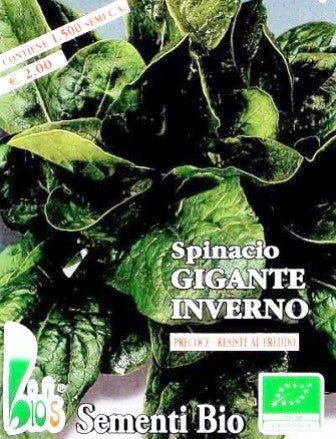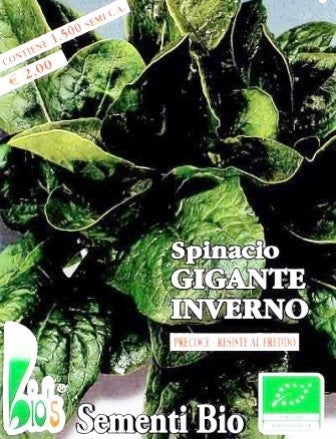Species: S. olareacea
Family: Chenopodiaceae.
English: Spinach; Spanish: Espinaca; German: Spinat; French: Epinard;
Origins.
Spinach is a vegetable known since ancient times and arrived in Europe from Iran around the year 1000 and from Spain it spread to other European countries then moving to America after 1500.
In Italy, its cultivation is widespread in all regions, particularly in Lazio, Tuscany, Campania, Veneto and Piedmont.
It is also widely grown in greenhouses for winter production in the North. Production is concentrated in the autumn and winter months.
Around 100,000 tons are produced annually throughout the peninsula, primarily for the frozen and dehydrated food industry. Spinach is highly prized as a cooked vegetable, with a dry matter content of 10% and 3.7% protein. It also has a high vitamin and mineral content. Its high iron content is legendary.
Spinach is an annual herbaceous plant with a red taproot near the base. Its basal leaves are fleshy, with a 5-10 cm long stalk and a 10-20 cm long smooth or blistered blade; they are gathered in a rosette of 20-30 leaves before the branched flower stalk develops.
The flowers are small, greenish, clustered in axillary clusters for the female plants and in spikes for the male plants. It is a dioecious species, but intermediate sexuality is also present depending on the cultivar and environmental conditions, which can influence sexual expression. Male plants are characterized by leafless flower stalks, while female plants have complete leaves reaching the tips of the stems.
Based on the shape of the fruit, two subspecies can be distinguished:
– Spinacia olracea inermis Moench (= glabra Mill), with smooth, sub-round fruits; it is the most widespread type in cultivation, with numerous cultivars;
– Spiny Spinacia oleracea Moench, with angular or spiny fruits; only a few varieties are known (Hollandia, Amsterdam and Cavallius) and, although they have good hardiness and resistance to cold, they are not very widespread in Europe, and are almost exclusively used for the canning industry.
Environmental needs
Spinach is a species with low thermal requirements and good cold tolerance during the rosette stage. It is a long-day plant, with rapid flower initiation with day lengths exceeding 14 hours (May-August).
It requires fresh, permeable, and well-drained soil with a pH above 6.5. It tolerates high salinity well. Its nutritional requirements are also moderate.
Rapid growth requires high and constant humidity; therefore, irrigation is recommended if the weather is adverse to planting and during the early stages of growth, also to prevent premature flowering.
Variety
The numerous cultivars can be distinguished based on the intended use of the product (market or industry), the shape of the leaf blade (broad, rounded, elongated), the intensity of blistering and the color (green or dark green), the growth habit (erect or prostrate), but at the cultivation level, the most important factor is the reaction to day length and resistance to bolting, which determine the possibility of cultivation in different periods of the year. There are two categories:
1. Autumn-winter cultivars: these are suitable for growing under short-day conditions, are highly vigorous and have good cold tolerance, but go to seed quickly under long-day conditions; they are sown in late summer-autumn (August-October) for autumn-winter production. (The Matador is well-known.)
2. Spring-summer cultivars: These are suitable for long-day cultivation, as they are slow to bolt; they are sown in spring (March-April) for spring-summer production. (America and The Summer Giant)
Cultivation:
Spinach, due to its short cycle, is often grown as a catch-all crop in the autumn-winter period, sown in August-September. It thrives best when planted in a four-year rotation. Spring crops are also grown, especially in central and northern Italy.
After ploughing the soil to a depth of 20-23 cm, the soil is refined and arranged in ridges (raised beds of 15 cm, about a metre wide and separated by passages of 35-40 cm), which are very important in autumn crops to avoid water stagnation.
Sowing can be done by broadcasting or by machine, in rows 20-30 cm apart, buried 1-2 cm deep; crop density varies depending on whether the crops are marketed (19-22 kg/ha of seed to achieve, after thinning, a density of 35-50 plants per square metre) or industrially (30-40 kg/ha of seed to achieve a density of 200-250 plants per square metre; the high density encourages the plants to grow upright, which is highly desirable for mechanical harvesting).
The subsequent work (in addition to thinning) is weeding, irrigation and, given its short cycle, a treatment of horn manure and one of horn silica.
Collection and production
Harvest takes place 40-60 days after sowing in spring crops; leaf removal or the entire plant can be performed; the root is cut just below the leaves; mechanical harvesting is widespread in industrial plants. Production is around 20,000 kg per hectare. The harvested spinach, once yellowed leaves have been removed, is placed in 10-15 kg crates and immersed in water to remove soil and improve the freshness of the leaves. Regarding the shelf life of fresh produce, the maximum shelf life is 15 days, stored refrigerated at 0°C and 95% relative humidity.
Adversities and parasites
A fairly hardy plant, few pests can attack it in the autumn-winter period, when temperatures are relatively low; but be careful to always perform correct crop rotations.
Plant parasites that cause root and collar rot include Pythium ultimum and Rhizoctonia solani.
Downy mildew (Peronospora farinosa f. sp. spinaciae) can also be harmful in high humidity and temperatures between 8 and 18°C. During the summer, anthracnose, cladosporiosis, and fusarium wilt are more damaging to seed crops. In these cases, horsetail decoction is a good preventative.
Aphid-borne viruses that can attack spinach include Cucumber virus, Spinach mosaic virus, and Swiss chard yellows virus.
The most harmful animal pests include, in addition to aphids, cutworms, snails and the Pegomya hyoscyami fly.
Various associations with spinach
Spring intercropping.
It should be sown early in spring, in rows 40 cm apart, leaving the rows free for planting potatoes, tomatoes, or radishes. When spinach growth threatens to overshadow other plants, it should be cut and left on the ground as a mulch layer, especially useful for reducing evaporation and, later, enriching the soil with organic matter.
The plants, cut to a depth of 2-3 cm, will no longer be able to produce leaves, and the remaining roots, tender and easily decomposed, will enrich the soil with organic matter. This model can be repeated the following year by sowing spinach in the rows where other vegetables were planted the previous year.
Early potatoes and spinach
This is a favorable companion planting due to the stimulating effect that the spinach root exudates have on the potato.
Spinach plants will be sown in the center of the field and on the outer edges, while potato plants will be sown in the remaining part.
Tetragony.
New Zealand spinach, or tetragonia, is a small leafy vegetable used like spinach in the summer. It is an annual herbaceous plant native to New Zealand and Australia, introduced to Europe by the English in the 18th century.
It has a succulent, herbaceous stem over a meter tall with many branches; the alternate leaves are smooth and fleshy with a short petiole (1-2 cm) and a triangular blade. The plants are hermaphroditic and produce hardened, angular, and horned axillary fruits that are used as seeds.
Given its high temperature requirements, it can only be grown in the spring and summer, sowing in open air in May. Although it is a hardy plant that adapts easily, it produces abundantly only in fertile soil, well-fertilized with mature manure compost, and with frequent, abundant irrigation.
Harvesting begins approximately 70 days after sowing, by detaching the basal and axillary leaves along the stem; the tips of the branches can also be cut in half at each harvest and used like the leaves. Under favorable conditions, harvesting, if carried out staggered throughout the summer, yields 200 quintals/ha of leaves and stems.
No particular parasites or adversities are known.




